7.1% of respondents who participated in our survey last year spent more than 50% of their SEO budget on link building, and another 17.7% allocated to it around 15-30%.
It’s understandable. Links have a huge impact on SEO performance. As an SEO or marketer, you don't need persuading.
But the senior execs at your organization? Or your agency clients?
That's another story. As marketing budgets are getting tighter, the pressure to justify how you spend every dollar increases.
That's why you calculate your link-building ROI.
In the article, I will show you how to do it. I will also explain why it's so difficult and share tips on how to increase it.
What is a Link Building ROI?
ROI, or return on investment, is a measure of investment profitability. It compares the amount you gain (or lose) on an investment relative to the cost of that investment.
In the context of link-building, the cost of investment is the money you spend on acquiring links, while the gain is the profit they bring to your business.
Some distinguish between short-term and long-term link-building ROI. That's the immediate gains in rankings and traffic within 3-6 months vs. long-term gains like increased domain authority over the years.
For me, the distinction is moot. SEO is a long-term game; quick gains don't always translate into long-term growth.
Key Metrics for Calculating the ROI of Link Building
When assessing the effectiveness of your link-building campaign, you usually consider these factors.
Higher keyword rankings
There's a correlation between search engine rankings and the number of backlinks. Backlinko data shows that pages ranking in the #1 spot have, on average, 3.8 times more backlinks than pages in positions #2-10.
The position in SERPs translates into higher CTR.
Climbing to #3 place can increase your CTR by about 10%. Going up from #3 to #1 can add another 30%.
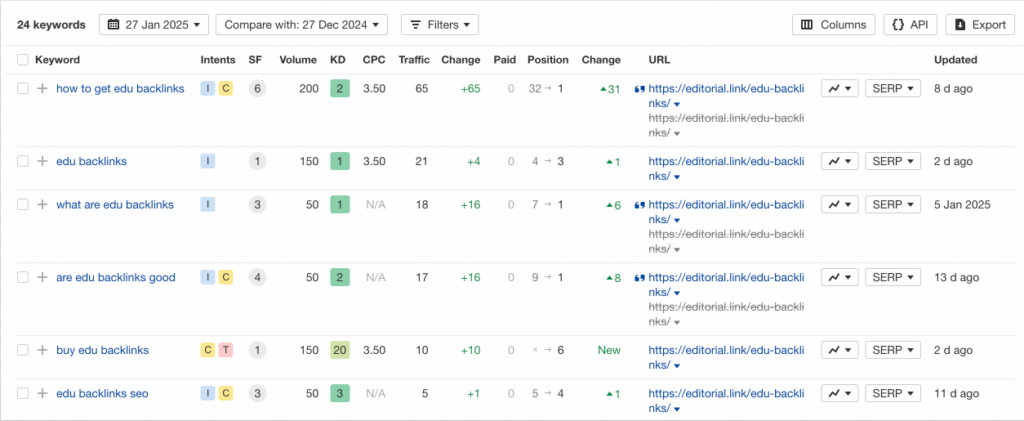
Growing organic search traffic
Many teams use organic traffic as their leading KPI.
The logic? The more visitors come to your website, the higher the chances they become customers, increasing the ROI.
Higher rankings mean higher CTR, which leads to an increase in organic traffic.
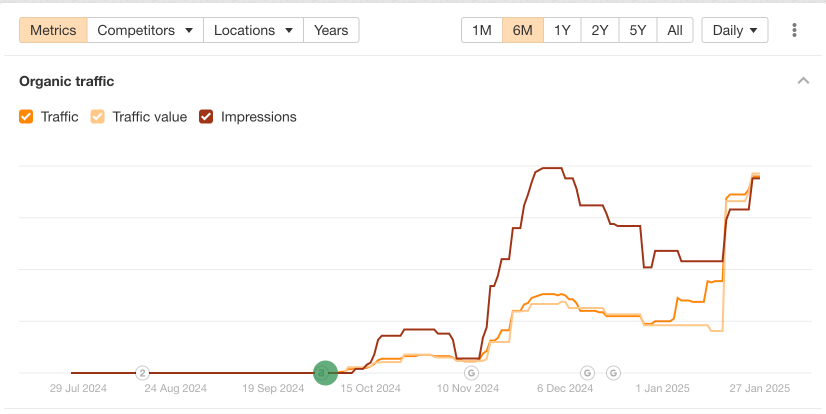
Increased referral traffic
Backlinks drive referral traffic, too.
That's the visitors who find your website by following the link from another referring domain. Who often become valuable leads.
Contrary to popular belief, referral traffic doesn’t have higher conversion rates than organic traffic, as illustrated by the First Page Sage chart.
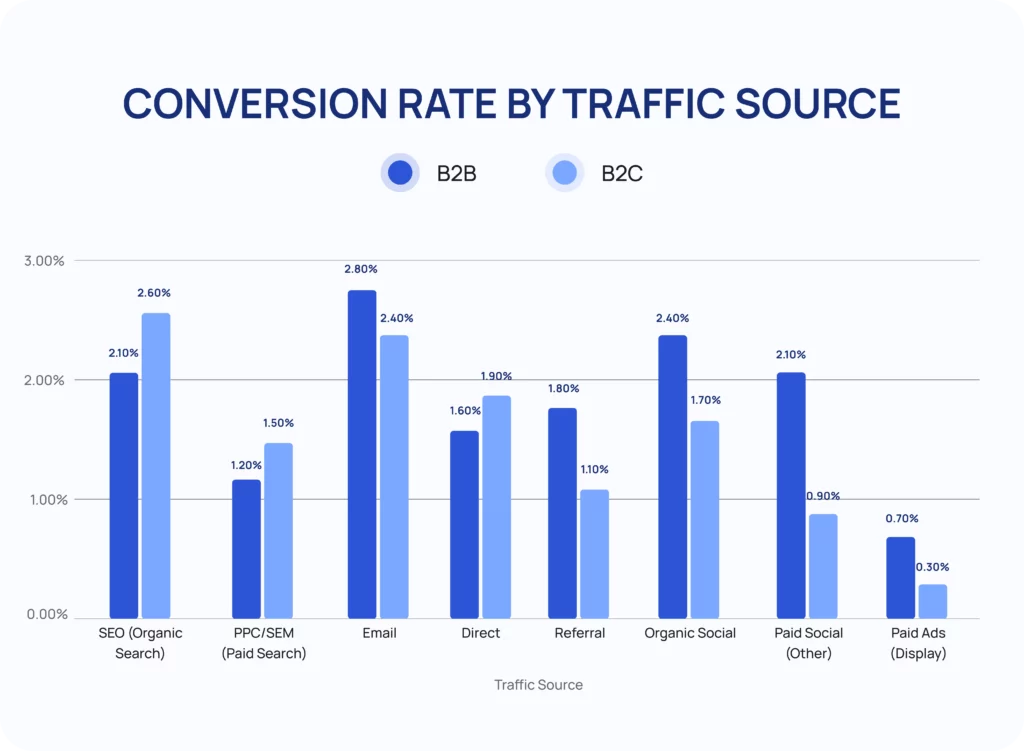
Four Ways to Calculate Link Building ROI
The formula for calculating ROI is straightforward: deduct the cost from the gain, divide it by the cost, and multiply by 100.
So if you spend $1000 on link-building and the links bring an extra $10,000 in revenue, the ROI is 900%:
ROI=((10,000-1,000)/1,000)x100=900%
Simple?
Yeah, but how do you determine how much you gain from the links?
Here are four ways to do it.
Calculate traffic value increase based on PPC
One way to calculate the monetary gains from your link-building efforts is by considering the traffic value.
Let's look at the data for our article about edu backlinks, which currently ranks in the #1 place for "how to get edu backlinks."
As you can see, the blog post brings monthly traffic worth $348. That's how much we'd need to spend on paid ads to bring the same number of visitors.
You can also see that the traffic value increased by $264 over the last month. Assuming this continues over 12 months, that's $3,168.
Imagine we built two backlinks, costing $600, to achieve this improvement.
That's an ROI of 428%.
ROI=(($3,168−$600)/$600)×100%=($2,568/$600)×100%=4.28×100%=428%
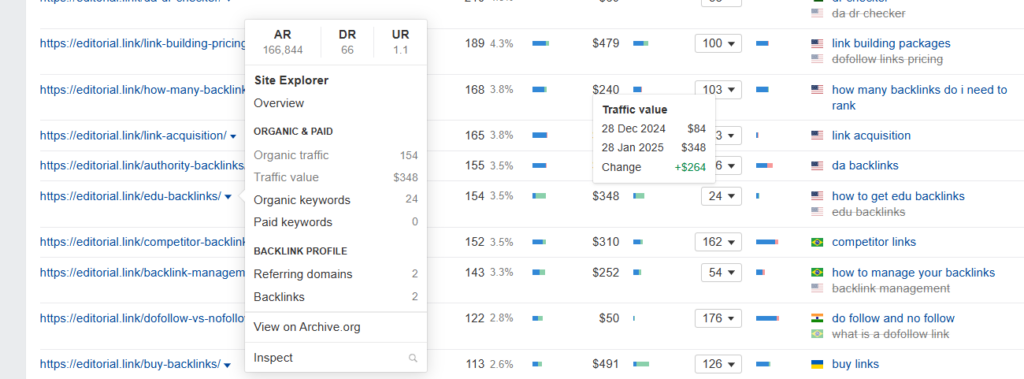
It's a ballpark figure only because we can't assume the traffic value remains the same every month.
Calculate ROI based on revenue growth
Using traffic value to calculate the ROI tells you how much you saved by investing in link building, not how much more you earned thanks to the increased traffic. To calculate the latter, use the revenue.
Imagine your online store had, on average, 100,000 sessions/month, bringing $10,000/month in revenue. That's $0.1 per session.
If you increased the traffic by 10%, your monthly revenue would increase by $1,000, and the annual revenue from $120,000 to $132,000.
You can get this data, with an exact breakdown by channel, by integrating your e-commerce platform with Google Analytics.
If the cost of links to achieve this growth were $5000, the ROI would be 140%.
ROI:
(((132,000-120,000)-5,000)/5,000))x100=((12,000-5,000)/5000)x100=(7,000/5,000)x100=141%
Calculate the ROI for ongoing link-building campaigns
The above calculations are simplistic.
In reality, one-off investments in links are rare. Instead, you invest regularly over a period of time, say a year, and this leads to incremental traffic growth.
Let's start with the same baseline: 100,000 sessions/month, bringing $10,000/month in revenue.
However, now you invest $2000/month over a 12-month period to achieve 10% traffic growth month-on-month. That's $24,000 spent a year.
Here's how your revenue would increase:
| Month | Sessions | Extra Over 100k | Extra Revenue ($0.10 each) |
| 1 | 100,000 | 0 | $0 (baseline month) |
| 2 | 110,000 | 10,000 | $1,000 |
| 3 | 121,000 | 21,000 | $2,100 |
| 4 | 133,100 | 33,100 | $3,310 |
| 5 | 146,410 | 46,410 | $4,641 |
| 6 | 161,051 | 61,051 | $6,105.10 |
| 7 | 177,156 | 77,156 | $7,715.60 |
| 8 | 194,872 | 94,872 | $9,487.20 |
| 9 | 214,359 | 114,359 | $11,435.90 |
| 10 | 235,795 | 135,795 | $13,579.50 |
| 11 | 259,374 | 159,374 | $15,937.40 |
| 12 | 285,312 | 185,312 | $18,531.20 |
| Total | $93,843 |
So, if you spent $24k on links to generate an extra $93,843 in revenue, your ROI would be around 291%.
ROI=(($93,843-$24,000)/$24,000)x100=291%
Calculate ROI based on conversion rates
If you're in SaaS, you can calculate your session value based on your web conversion data: how many visitors convert into sign-ups (free trial or demo bookings) and how many convert to paying customers. And the average customer value.
So if you get 100,000 visitors every month, the sign-up rate is 6%, your freemium-to-premium conversion is 5%, and your lifetime customer value is $1400, then each visitor is worth $9.
Link Building ROI Challenges
Some calculation methods are more accurate than others, but there are too many factors that make calculating the exact return rather impossible.
Attribution is a nightmare
The odds are that link-building isn't the only thing you do to improve your search results. This makes it difficult to attribute improvements in your KPIs to links.
For example, your blog posts may perform better because you've updated them recently or invested in their promotion.
Your content update may have involved title and meta description optimization, resulting in a higher CTR and more traffic, even without improving your search rankings.
Similarly, better CTAs can increase conversions—and, consequently, your revenue—even if the traffic remains the same. This will mess up your revenue-based ROI calculations.
Estimating the costs is tricky
If you hire an agency or a freelancer to deliver a link package, estimating the cost isn't difficult.
However, if you build them in-house, things get tricky. It isn't just the link-builder salaries but also their tools, the cost of content creation, design, and so much more.
You may also use both — build some links in-house and outsource some of them to external providers. This makes things even more complicated.
Results are delayed
Links don’t bring immediate results. As a rule of thumb, it takes at least 3 months for them to start working their magic.
Once they do, they don’t give a one-off boost but keep working for you into the future.
Search engine algorithms change
Over the last 18 months, Google algorithm updates have wreaked havoc in search results.
Many websites, including the likes of Hubspot, saw their traffic hit rock bottom, while Reddit threads seem to dominate SERPs in almost every niche.
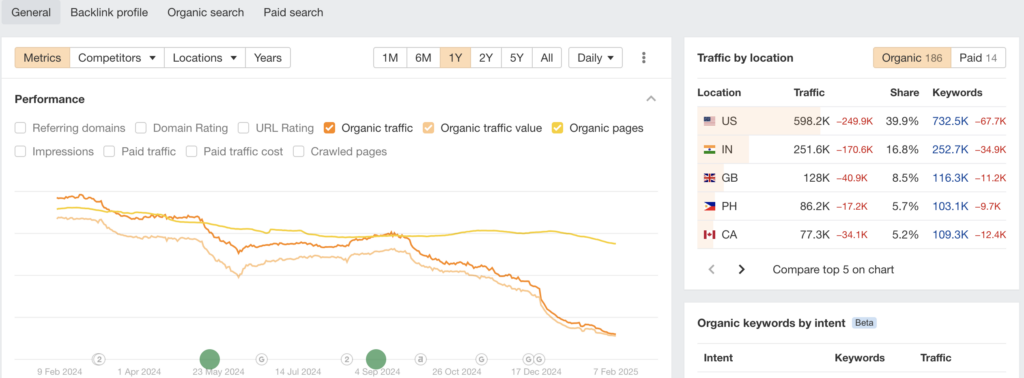
The consequence? You can’t tell if your gains (or losses) are caused by your actions or algo changes. Or use historical data to predict future ROI.
Indirect backlink benefits
In addition to the obvious benefits, like increased traffic, which leads to higher revenue, links contribute to your business's success indirectly.
These include:
Increased brand awareness
Links may increase your content impressions in SERPs, for example, in featured snippets or AI overviews. This may not bring extra traffic, but it makes your brand more recognizable.
Higher customer trust
A link in a national paper or an influencer blog can increase your trustworthiness in the eyes of potential customers. This may affect their behaviors, such as the decision not to switch to your competitor.
The Halo effect
As links improve your domain authority, they help all your content rank. That's all your pages—existing and future ones.
Easier link acquisition
Organic link acquisition is easier if your content appears higher in search results, and higher DA/DR makes you a more desirable link-building partner.
These are incredibly valuable side effects, which are difficult to quantify, making the ROI calculations incomplete.
9 ways to increase link-building ROI
Let's wrap up with a few tips on how to increase the ROI of link-building for your company—or your clients.
- Build links to all pages, not just your money pages. Building links to your blog posts or case studies is easier and brings similar long-term benefits.
- Invest in evergreen content that will continue to attract links long into the future.
- Prioritize high-quality backlinks from authoritative websites as they pass more link equity.
- Don’t waste your resources on going after domains that are ‘out of your league.’
- Leverage your existing networks to get links for "free." ABC exchanges may be a gray hat tactic. But they work.
- Optimize conversions: By improving conversion rates, you increase the session value.
- Use various tactics to diversify your link profile and protect it from unpredictable algo updates.
- Constantly monitor your backlinks to slow down the link rot.
- Repurpose successful link-bait content, for example, as infographics or videos.
How Working With a Reputable Link-Building Agency Can Increase Your ROI
Working with reputable agencies with a proven track record in your niche can increase your ROI dramatically.
- Guaranteed results: When you build links in-house, you cannot guarantee success. An agency charges you for links that they deliver.
- Link replacement guarantee: If your link disappears, a good agency will restore or replace it free of charge within a certain period (6 months for Editorial.Link).
- Bespoke link-building strategies: A good agency will develop a link-building strategy tailored to your goals, maximizing its impact.
- Quicker results: Link-building agencies can deliver links faster, thanks to established industry relationships and processes.
- Reduced risk: Good agencies won't risk their reputation using dodgy tactics. This reduces the risk that your links will disappear or you will get penalized.
- Economy of scale: By buying larger link packages or signing retainer contracts, you get a better deal per link.
Final Words
Calculating the exact ROI of your link-building campaign is impossible. The accuracy of all the calculation methods, even the most granular ones, is reduced by factors like inaccurate cost estimates, inadequate attribution, and algo updates.
And some benefits, like greater brand awareness, cannot be expressed in monetary terms.
Although you can't calculate the ROI accurately, you can do plenty to increase it. For example, by working with a reputable link-building service, like Editorial.Link.
Get in touch to talk about your link-building needs.

